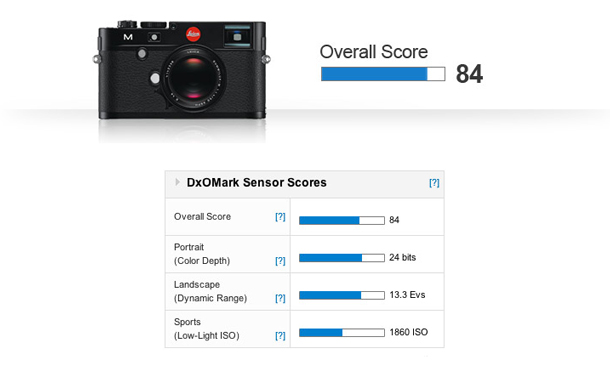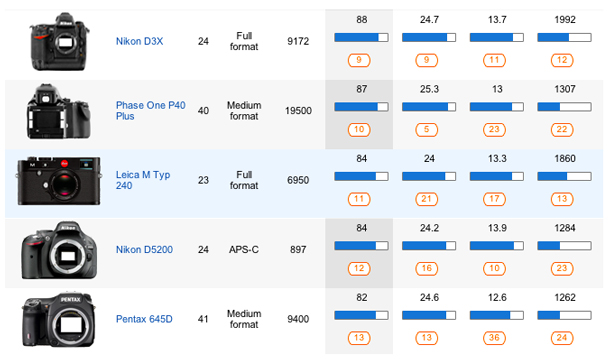As pointed out by Leica Rumors, the Leica M Typ 240 image quality scores tested by DxOMark provide a welcome boost for the Leica M. The improvements over the retired M9 model are significant, but strictly technically speaking the M is still not playing in Nikon’s full-frame or the Sony RX1 league, says DxOMark’s Leica M sensor analysis:

Featuring a new higher resolution sensor and updated functionality expectations are high for the new Leica M and it doesn’t disappoint. Although remaining true to their “no gimmicks” approach the addition of an improved LCD screen with live view, as well as the increased ISO sensitivity range are welcome additions that update Leica’s digital rangefinder for the modern era.
The latest 24MP CMOS sensor offers not only six million extra pixels but DxOMark’s sensor scores indicate a +1 stop improvement in overall image quality compared to the previous 18MP CCD sensor. As well as offering more consistent color sensitivity across the ISO range there’s also an impressive extra +1.6 stops boost for dynamic range and its low light ISO scores are improved too, again beating previous versions by around +1 stop.
So a big step in the right direction although the new sensor doesn’t quite match the heights of the best sensors DxOMark have tested or those of flagship DSLRs. Compared to the best sensors the Leica M is a little off the pace with the Sony RX1 and Nikon D800 boasting around +1 stop better image quality overall.
Against the Nikon D4 and Canon 1Dx the overall scores indicate the Leica M is either better or not far off in terms of color sensitivity and dynamic dange. These overall scores are a little misleading however as image quality on the M drops quickly as ISO sensitivity is increased compared to this DSLR competition, which deliver a more consistent performance up to ISO 3200.
Nonetheless a welcome improvement in image quality demonstrates Leica made a wise choice switching to a CMOS sensor. If you’re after a Leica digital rangefinder and your budget can stretch to $6,950 the new M offers better image quality, features and functions compared to the $5,450 M-E Typ 220.
Disclaimer! Obviously many of the reasons why photographers love and shoot Leica are not reflected in these tests that examine only the sensor, and not the lenses, handling, size, process, simplicity, involvement, not to mention the camera’s own overall draw. Still, after bashing DxOMark’s M9 test the Leica community welcomes this shining report with enthusiasm.
The 18MP CCD previously used in Leica M rangefinders hasn’t fared well DxOMark tests towards the bottom for full-frame sensors. The new 24MP CMOS model marks a big step forward boasting 6 million more pixels than its predecessor and delivering a 1 stop improvement in image quality, too. with a +1 stop improvement for both color depth and ISO, as well as an impressive +1.6 stops better dynamic range, it seems switching to a CMOS sensor was certainly a good move for Leica.
According to DxOMark it’s “interesting to note too that no RAW smoothing is applied to files from the new model, as was previously the case from ISO 400 on earlier versions.” It goes without saying, however, that no digital signal ever leaves a sensor without some kind of processing.
Overall, the M definitely looks like a step in the right direction. An almost 22% improvement in the overall score over the M-E, equalling roughly 1.5 stops gained in real world use, says something.

Still, hold your breath. Sony might bring a full-frame NEX-9 on the market late this or early next year. That sensor will most likely smoke the M, but honestly, as outstanding NEX cameras have become, Sony sensors are plain amazing, NEX ergonomics are a different story.
Whatever camp you’re from, looks like the M is an worth upgrade in any case — even when moving over from a Nikon D800… size, gentlemen, size!
Pair this M with the right glass and you’ll be set for years.
+++ You can order the Leica M from Amazon (black/chrome), B&H (black/chrome) or Adorama (black/chrome).


